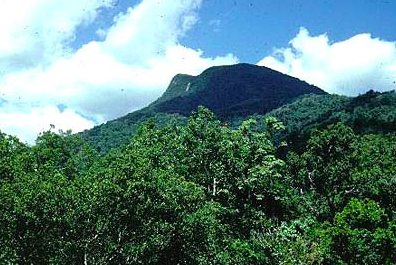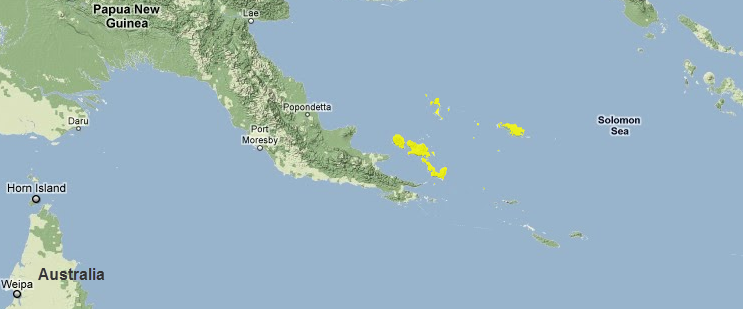Trobriand Islands rain forests
The islands of this ecoregion have been separated from mainland New Guinea since the late Pleistocene, and much of the biota is unique, including four mammal species and two birds-of-paradise. The main threats to the ecoregion include logging by foreign companies and conversion of habitat into agricultural lands.
Location and General Description
The ecoregion lies just off the southeastern tip of Papua New Guinea (PNG) in the southwest Pacific and includes Woodlark Island and two island groups: the D'Entrecasteaux and the Trobriand. The largest portion of the ecoregion and the nearest to the New Guinea mainland is made up of three principal islands of the D'Entrecasteaux group: Goodenough, Fergusson, and Normanby. Goodenough is the highest island in the ecoregion, reaching an altitude of 2,750 meters (m), and Fergusson is the largest. Kaileuna and Kiriwina islands in the Trobriand group lie further out in the Pacific, and Woodlark Island is even further to the southwest. The ecoregion is warm and moist tropical, typical of most of New Guinea.
According to Whitmore, Woodlark and the Trobriand Islands consist primarily of lowland rain forest on limestone substrates. Goodenough, Fergusson, and Normanby islands consist mainly of lowland rain forest on acid soil; however, Normanby has one area of ultrabasic soils. The major rain forest tree genera include Pometia, Octomeles, Alstonia, Campnosperma, Canarium (Burseraceae), Dracontomelon (Anacardiaceae), Pterocymbium (Sterculiaceae), Crytocarya (Lauraceae), Intsia, Ficus, and Terminalia. The emergent hoop pine (A. cunninghami) is present in the ecoregion on Fergusson. The northwest portions of Goodenough and Fergusson islands are anthropogenic grasslands and agricultural lands.
Biodiversity Features
The ecoregion has many endemic species, but more certainly await discovery. The D'Entrecasteaux Islands in particular are thought to contain numerous endemic plant species. The ultrabasic soils of Normanby have turned up exciting new finds, including two endemic ant-plant species. The forested mountains of Fergusson Island have never been surveyed biologically and are considered one of PNG's great biological unknown. Beehler emphasized this point, saying that the massif on Fergusson "promises to be a treasure trove to the first vertebrate biologists who climb its heights," and "one can only imagine what undescribed populations of vertebrates inhabit the wet montane forests above 1500 m there." Goodenough Island contains an endemic bat (Dobsonia pannietensis) and an endemic forest wallaby, the black dorcopsis (Dorcopsis atrata). Woodlark Island is also considered to be very unusual botanically and contains an endemic cuscus (Phalanger lullulae).
|
Table 1. Endemic and Near-Endemic Mammal Species. Family Species Perorictidae Echymipera davidi* Phalangeridae Phalanger lullulae* Macropodidae Dorcopsis atrata* Petauridae Dactylopsila tatei* Pteropodidae Nyctimene major Pteropodidae Pteropus pannietensis Vespertilionidae Kerivoula agnella Vespertilionidae Pipistrellus collinus Muridae Chiruromys forbesi An asterisk signifies that the species' range is limited to this ecoregion. There are thirty-eight mammal species in the Trobriand Islands Rain Forests. Most of these species are bats (twenty-four) in four families (Pteropodidae, Molossidae, Rhinolophidae, and Vespertilionidae), followed by rodent species (Muridae). Three species are listed as threatened (VU or higher) by IUCN: black dorcopsis (Dorcopsis atrata), St. Aignan's trumpet-eared bat (Kerivoula agnella), and Tate's triok (Dactylopsila tatei). Four mammal species are limited to the ecoregion (Trobriand Islands rain forests) , and five more are near endemics (Table 1). {| border="1" cellpadding="3" align="right" ! colspan="3" align="center" | Table 2. Endemic and Near-Endemic Bird Species. Family Common Name Species Paradisaeidae Curl-crested manucode Manucodia comrii* Paradisaeidae Goldie's bird-of-paradise Paradisaea decora* An asterisk signifies that the species' range is limited to this ecoregion. Most of the ecoregion (Trobriand Islands rain forests) , with the notable exception of Woodlark Island, is part of the D'Entrecasteaux and Trobriand Islands Endemic Bird Area, EBA. Two bird species are endemic to the ecoregion (Table 2). One of these birds, the curl-crested manucode, is found on all three major islands of the D'Entrecasteaux group and in the Trobriand Islands. The other, Goldie's bird-of-paradise, is listed as threatened (VU) by IUCN and is found only on Fergusson and Normanby. ==Current Status== {| width="420" border="1" cellpadding="3" align="right" |- align="center" ! colspan="3" | Table 3. WCMC (1997) Protected Areas That Overlap with the Ecoregion. Protected Area Area (km2) IUCN Category Lake Lavu 40 VIII Ecoregion numbers of protected areas that overlap with additional ecoregions are listed in brackets. As mentioned earlier, the northwest portions of Goodenough and Fergusson islands are anthropogenic grasslands and agricultural lands. A scheme for a possible large-scale agricultural project on Normanby Island is mentioned by Stattersfield et al., but its status is unknown. The only protected area found in these islands is Lake Lavu (Table 3). (Trobriand Islands rain forests) ==Types and Severity of Threats== The main threats to the biodiversity of the ecoregion are logging and conversion of forest to agriculture. However, it is hard to obtain any detailed information on the current or future threats to the islands. ==Justification of Ecoregion Delineation== The Trobriand Islands Rain Forests and Louisiade Archipelago rain forests were made distinct [[ecoregion]s] based on Stattersfield et al. MacKinnon placed these two ecoregions together into subunit P3o. Udvardy placed these ecoregions in the Papuan biogeographic province of the Oceanian Realm. ==Additional Information on this Ecoregion== * For a shorter summary of this entry, see the WWF WildWorld profile of this ecoregion. * To see the species that live in this ecoregion, including images and threat levels, see the WWF Wildfinder description of this ecoregion. * World Wildlife Fund Homepage |
|---|

